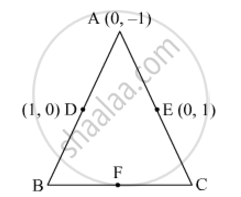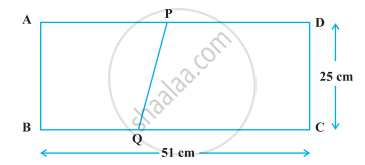Advertisements
Advertisements
प्रश्न
Find the centroid of ΔABC whose vertices are A(-1, 0) B(5, -2) and C(8,2)
उत्तर
`Here , (x_1 = -1, y_1=0),(x_2 = 5, y_2 =-2) and (x_3 = 8 , y_3 =2) `
Let G (x,y) be the centroid of the Δ ABC . Then ,
`x= 1/3 (x_1 +x_2+x_3) = 1/3 (-1+5+8)=1/3(12)=4`
`y=1/3 (y_1 +y_2 +y_3) =1/3 (0-2+2) = 1/3 (0) = 0`
Hence, the centroid of ΔABC is G (4,0).
APPEARS IN
संबंधित प्रश्न
In Fig. 6, ABC is a triangle coordinates of whose vertex A are (0, −1). D and E respectively are the mid-points of the sides AB and AC and their coordinates are (1, 0) and (0, 1) respectively. If F is the mid-point of BC, find the areas of ∆ABC and ∆DEF.

Determine the ratio in which the line 2x + y – 4 = 0 divides the line segment joining the points A(2, – 2) and B(3, 7).
If G(-2, 1) is the centroid of a ΔABC and two of its vertices are A(1, -6) and B(-5, 2) , find the third vertex of the triangle.
Show that the points (a + 5, a – 4), (a – 2, a + 3) and (a, a) do not lie on a straight line for any value of a.
Points A(–6, 10), B(–4, 6) and C(3, –8) are collinear such that AB = `2/9` AC.
The dimensions of a rectangle ABCD are 51 cm × 25 cm. A trapezium PQCD with its parallel sides QC and PD in the ratio 9 : 8, is cut off from the rectangle as shown in the following figure. If the area of the trapezium PQCD is `5/6` th part of the area of the rectangle, find the lengths QC and PD.

Find the missing value:
| Base | Height | Area of parallelogram |
| ______ | 15 cm | 154.5 cm2 |
Find the missing value:
| Base | Height | Area of parallelogram |
| ______ | 8.4 cm | 48.72 cm2 |
In the given figure, if PR = 12 cm, QR = 6 cm and PL = 8 cm, then QM is ______.

Area of a triangle = `1/2` base × ______.
